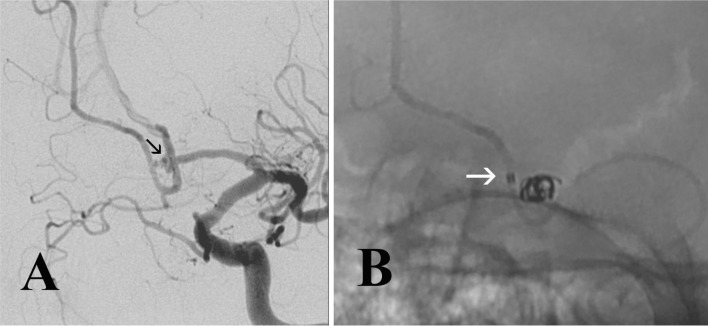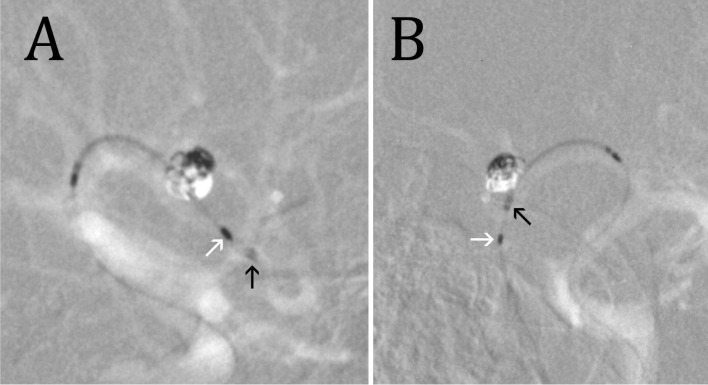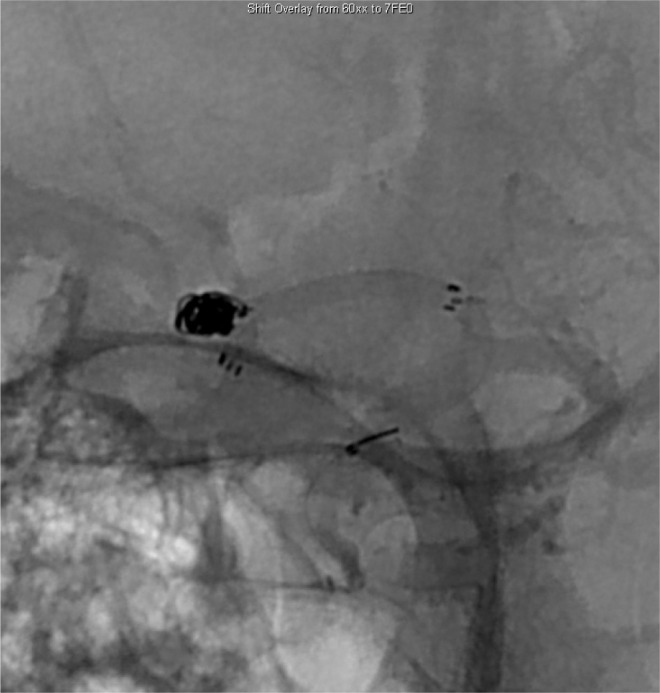Neurointervention.
2013 Sep;8(2):101-104. 10.5469/neuroint.2013.8.2.101.
Neuroform-EZ Stent Modification for Facilitated Delivery during Intracranial Aneurysm Embosurgery
- Affiliations
-
- 1Department of Radiology, Division of Neuroradiology, Section of NeuroInterventional Surgery, Texas A&M University Health Sciences Center College of Medicine/Scott & White HealthCare, TX, USA. wlesley@sw.org
- 2Department of Surgery and Neurosurgery, Division of Neuroradiology, Section of NeuroInterventional Surgery, Texas A&M University Health Sciences Center College of Medicine/Scott & White HealthCare, TX, USA.
- KMID: 1784026
- DOI: http://doi.org/10.5469/neuroint.2013.8.2.101
Abstract
- The Neuroform EZ Stent System is a fourth generation intracranial aneurysm stent that utilizes an integrated navigation guidewire. While designed to facilitate stent delivery, the guidewire can rarely impede proper positioning of the stent. In this technical case report, severing the guidewire from the stent delivery system with surgical scissors was required for successful stent implantation.
Figure
Cited by 1 articles
-
Enlarged Parent Artery Lumen at Aneurysmal-Neck Segment in Wide-Necked Distal Internal Carotid Artery Aneurysms
Jong Won Lee, Jung Min Woo, Ok Kyun Lim, Ye-eun Jo, Jae Kyun Kim, Eun Sang Kim, Deok Hee Lee
Neurointervention. 2015;10(2):82-88. doi: 10.5469/neuroint.2015.10.2.82.
Reference
-
1. Neuroform EZ Stent System. Directions for use. Fremont (CA): Boston Corporation;2012.2. Gu DQ, Zhang X, Luo B, Long XA, Duan CZ. The effect of Neuroform stent-assisted coil embolization of wide-necked intracranial aneurysms and clinical factors on progressive aneurysm occlusion on angiographic follow-up. J Clin Neurosci. 2013; 20:244–247. PMID: 23201094.
Article3. Santillan A, Greenberg E, Patsalides A, Salvaggio K, Riina HA, Gobin YP. Long-term clinical and angiographic results of Neuroform stent-assisted coil embolization in wide-necked intracranial aneurysms. Neurosurgery. 2012; 70:1232–1237. PMID: 22095221.
Article4. Kim YJ. Early experiences of neuroform stent-assisted coiling in ruptured intracranial aneurysms. Interv Neuroradiol. 2007; 13:31–44. PMID: 20566127.
Article5. Thomas JA, Watson VE, McGrail KM. Surgical management of a paraclinoid aneurysm containing a displaced neuroform microstent: technical case report. Neurosurgery. 2008; 63:E817. PMID: 18981851.
- Full Text Links
- Actions
-
Cited
- CITED
-
- Close
- Share
- Similar articles
-
- Initial Experience with Neuroform EZ in the Treatment of Wide-neck Cerebral Aneurysms
- Delayed Self-expansion Phenomenon as a Complication of Neuroform Stent Assisted Coiling for Ruptured Intracranial Aneurysm
- Jailing Technique Using a Catheter-based Open-cell Stent System in Internal Carotid Artery Sidewall Aneurysms Unfeasible to Simple Coiling
- Overlapping Stents-Assisted Coiling for Vertebral Artery Dissecting Aneurysm : LVIS Stent within Neuroform EZ Stent
- Safety and effectiveness of Neuroform Atlas stent-assisted coil embolization for ruptured intracranial aneurysms





